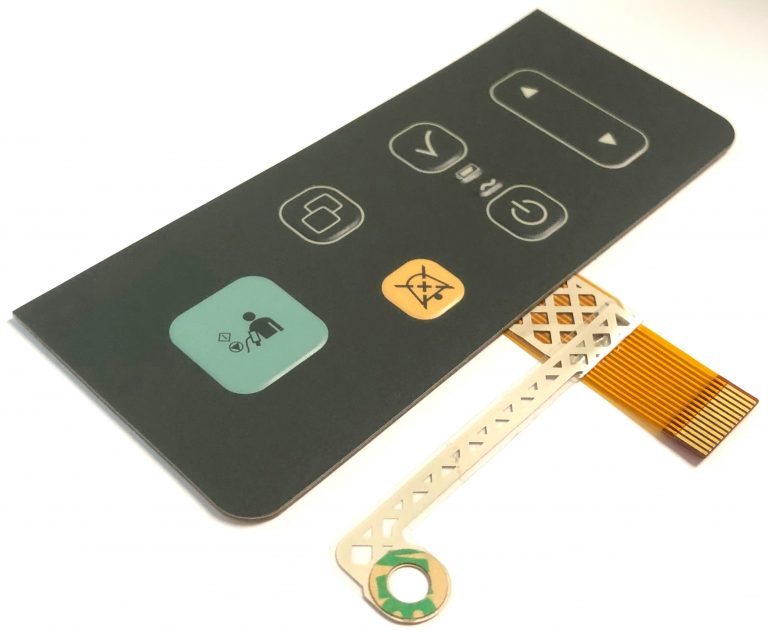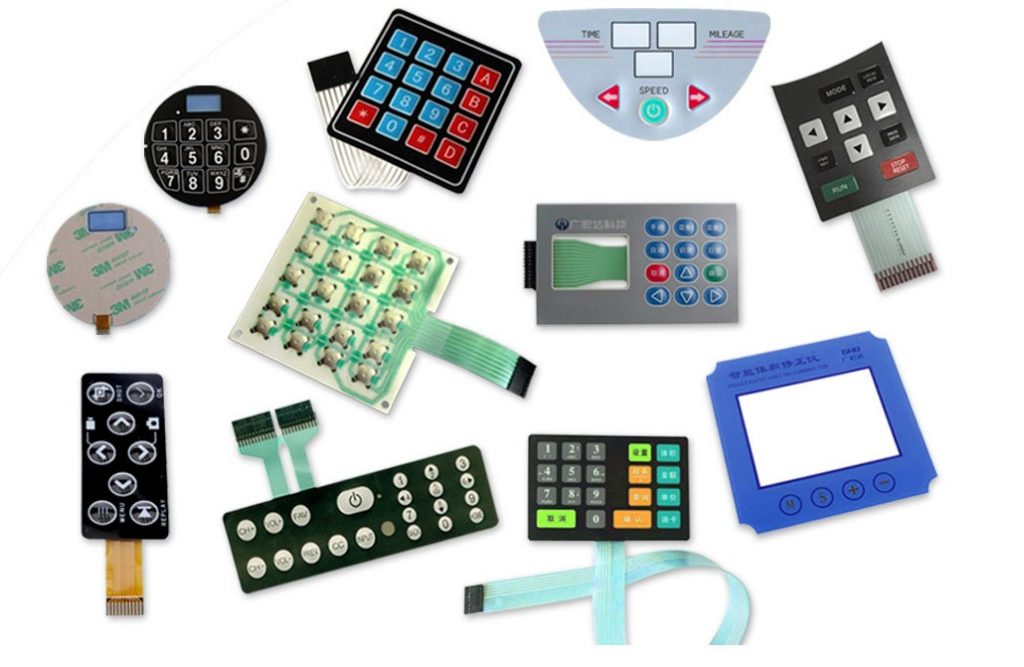All Concerning Membrane Switch Over: A Comprehensive Overview for Beginners
Membrane buttons are vital components in modern-day electronic devices, providing an unique user interface for individual interaction - membrane switch. Their layered building, including overlays and conductive traces, supplies performance and durability. Unlike typical mechanical switches, membrane layer buttons provide a smooth design and adjustable options. Recognizing their key attributes and benefits can transform item design. Nonetheless, the complexities of their application and design considerations call for further exploration
What Is a Membrane Change?
A membrane layer switch is a kind of electric switch that consists of a flexible membrane layer layered over a published circuit card. This style permits for a compact and smooth interface, frequently used in numerous digital tools. Membrane buttons are generally located in consumer devices, clinical devices, and industrial machinery because of their durability and resistance to environmental factors.The building commonly consists of multiple layers, such as graphic overlays and adhesive backing, which offer responsive comments and secure the wiring beneath. The procedure of a membrane layer button is launched when stress is applied to the surface, completing an electrical circuit.These switches are valued for their flexibility, enabling custom-made designs and published graphics that accommodate certain customer interfaces. Their inconspicuous nature reduces space requirements, making them perfect for applications where conventional buttons might not fit. Generally, membrane layer switches provide a aesthetic and functional solution for modern electronic devices.
Trick Elements of Membrane Switches
Membrane layer changes comprise numerous key elements that add to their functionality and efficiency. The top layer, referred to as the overlay, provides the individual interface and is often printed with icons or graphics. Underneath the overlay lies a spacer layer, which divides the conductive aspects and stops unintended activation. The next important element is the graphic layer, which enhances visual appeals and assures the longevity of the design.Conductive traces, commonly made from products like silver or carbon, are printed on the circuit layer. When stress is put on the overlay, these traces enter into call, finishing the circuit. Additionally, a support layer offers structural support and can be made from materials such as polyester or polycarbonate. With each other, these elements produce a reputable, easy to use user interface suitable for various applications, from home home appliances to commercial devices. Recognizing these components is vital for any person interested in membrane layer button innovation.
Just How Membrane Switches Over Work
Comprehending exactly how membrane switches over function is necessary for appreciating their extensive usage in different gadgets. A membrane layer switch operates through a collection of layers, consisting of a visuals overlay, spacer, and a circuit layer. When pressure is related to the overlay, it compresses the spacer layer, enabling the circuit layer to make call and complete an electric circuit. This activity sends a signal to the tool, prompting an action, such as switching on a light or turning on a function.Membrane switches can be developed with numerous attributes, including tactile responses, backlighting, and customized graphics, improving individual communication. Their building enables a covered layout, protecting the interior parts from dirt, moisture, and contaminants. This resilience makes them appropriate for diverse applications, from customer electronics to industrial tools. On the whole, the simpleness and effectiveness of membrane switches add to their popularity in modern technology.
Benefits of Membrane Layer Switches Mechanical Switches
While mechanical buttons have actually long been a staple in several tools, membrane changes offer distinctive advantages that make them significantly appealing. One substantial benefit is their slim account, permitting for more compact layouts and greater adaptability in product growth. Furthermore, membrane layer switches over feature an uniform surface, which boosts visual charm and streamlines cleansing, making them appropriate for environments where health is critical.Another advantage is their resistance to dirt and wetness. Unlike mechanical switches, which can be jeopardized by environmental elements, membrane layer buttons offer a sealed interface that secures against impurities - membrane switch. Membrane layer buttons usually have a longer lifespan due to fewer moving components, resulting in enhanced sturdiness and reliability.Cost-effectiveness is likewise a remarkable benefit, as membrane layer switches can be created in mass with reduced production prices. These variables incorporate to position membrane layer switches as a functional choice to typical mechanical alternatives in numerous applications
Usual Applications of Membrane Layer Switches Over
Membrane switches are commonly utilized in various markets, specifically in consumer electronics and industrial control panels. In consumer devices, they give a sleek, straightforward interface, while in commercial settings, they boost toughness and functionality. Comprehending these applications highlights the convenience and functionality of membrane switches in modern-day technology.
Consumer Electronic Devices Tools
As customer electronics remain to progress, membrane layer buttons have actually come to be a preferred choice for a selection of tools as a result of their flexibility and smooth design. These switches are frequently discovered in mobile phones, tablets, and remote controls, where space is limited and looks matter. Their reduced profile and customizable layouts permit manufacturers to create user-friendly user interfaces that boost the total individual experience. Additionally, membrane layer buttons are often made use of in appliances such as microwaves and coffee machine, supplying intuitive control alternatives while withstanding wetness and dust. The resilience and integrity of membrane layer switches over make them appropriate for everyday customer items, guaranteeing long life webpage and consistent efficiency. Overall, their combination in customer electronics mirrors a mix of performance and modern layout.
Industrial Control Panels
The applications of membrane switches over expand beyond consumer electronic devices, discovering significant use in commercial control board. These switches are favored for their resilience and resistance to rough environments, making them perfect for producing and procedure control settings. They give a reputable interface for operators to control equipment, monitor procedures, and adjust settings. Membrane buttons can be tailored to suit specific operational demands, incorporating features like backlighting and responsive feedback, boosting customer experience. Their low-profile style enables integration right into numerous equipment, while their capacity to withstand spills, dirt, and severe temperature levels assurances durability. Overall, membrane buttons add to efficient and secure operation in industrial applications, demonstrating their flexibility and performance in requiring atmospheres.
Considerations for Designing Membrane Switches
When creating membrane buttons, selecting the right materials is necessary to guarantee toughness and performance. In addition, understanding layer setup techniques can significantly influence the switch's performance and user experience. These factors to consider play a crucial duty in developing efficient and reliable membrane button designs.
Product Option Value
Product option plays an important role in the design and functionality of membrane layer switches. The chosen materials straight affect the switch's durability, tactile reaction, and general visual. Secret considerations include the substrate, which must offer architectural stability while permitting versatility, and the visuals overlay, which requires to be resistant to put on and environmental factors. Conductive products ought to ensure trustworthy electrical performance, while adhesives should supply look at this web-site solid bonding without endangering the button's procedure. In addition, compatibility with making processes and end-user atmospheres is essential; products should hold up against differing temperatures, moisture levels, and chemical direct exposure. Eventually, proper material selection not only enhances the membrane switch's performance however additionally contributes to its durability and individual complete satisfaction, making it a my latest blog post critical facet of the layout procedure.

Layer Setup Techniques

Often Asked Inquiries
For How Long Do Membrane Layer Switches Over Commonly Last?
Membrane layer switches typically have a life-span of 1 to 5 million cycles, depending on usage and ecological conditions. Factors such as layout quality and operating regularity substantially affect their sturdiness and total efficiency durability.

Can Membrane Layer Changes Be Personalized for Particular Layouts?
Membrane layer buttons can without a doubt be personalized to fit specific styles, enabling diverse shapes, shades, and capabilities. This adaptability enables makers to tailor these buttons to fulfill unique aesthetic and operational requirements efficiently.
What Products Are Utilized in Membrane Switch Over Building?
Membrane buttons are commonly constructed making use of materials such as polyester, polycarbonate, and glue layers. These materials provide versatility, resilience, and resistance to environmental elements, ensuring the buttons work efficiently in numerous applications and problems.
Are Membrane Layer Switches Water Resistant or Resistant to Dampness?
Membrane layer buttons can be made to be moisture-resistant, using specialized layers and materials. However, their water resistant capabilities rely on building and construction high quality and details applications, making it necessary to evaluate demands for ideal performance in various atmospheres.
Exactly How Are Membrane Layer Switches Over Fixed if Harmed?
Fixing broken membrane layer switches usually involves changing the affected layer or circuit. Technicians might also use conductive sticky or make use of specialized fixing packages, ensuring performance is restored without total replacement of the whole button assembly. Unlike typical mechanical switches, membrane layer switches present a streamlined style and customizable options. A membrane layer button is a kind of electric switch that is composed of a versatile membrane layer layered over a printed circuit board. The operation of a membrane layer button is initiated when stress is used to the surface, finishing an electric circuit.These buttons are valued for their convenience, enabling custom designs and published graphics that provide to particular individual interfaces. While mechanical buttons have actually long been a staple in several devices, membrane layer switches deal distinct benefits that make them significantly appealing. Membrane layer buttons usually have a longer lifespan due to less moving parts, resulting in boosted durability and reliability.Cost-effectiveness is additionally a notable benefit, as membrane layer buttons can be created in mass with lower manufacturing costs.